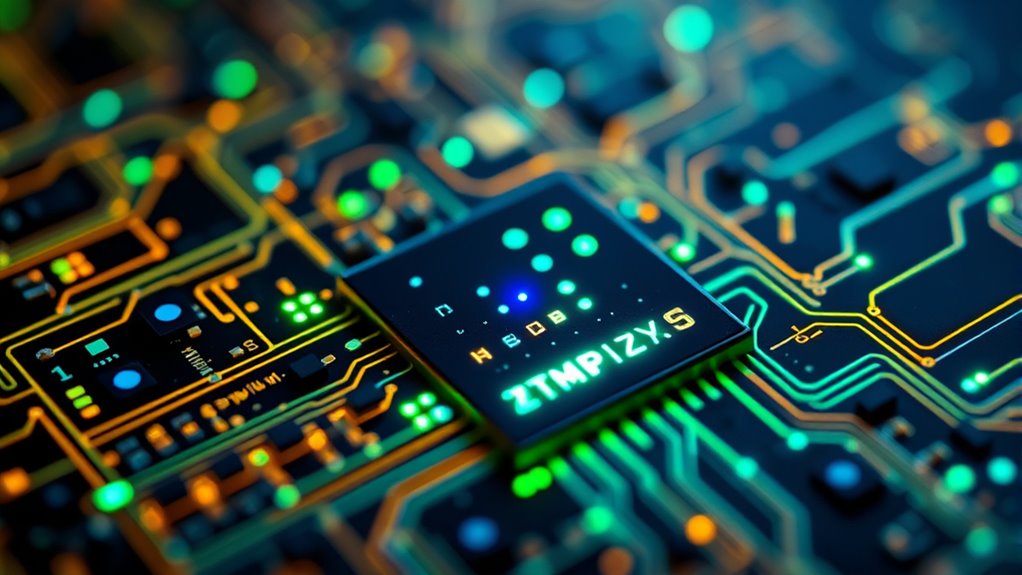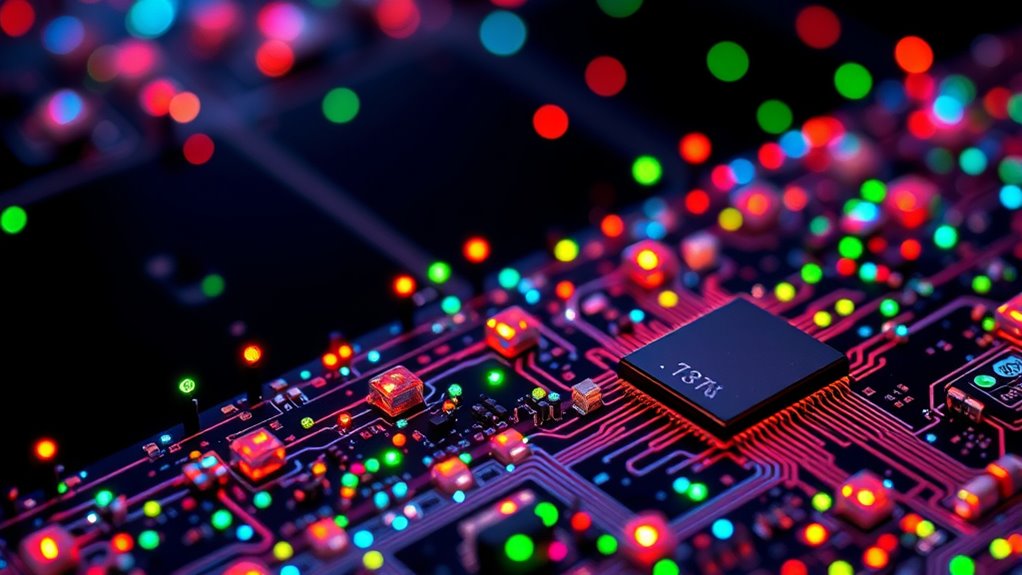Semiconductor nanodevices like nanoscale transistors and quantum dots are revolutionizing electronics by making devices faster, smaller, and more efficient. You control electron flow with tiny transistors that operate at the quantum level, and quantum dots emit specific wavelengths by adjusting their size. Advanced fabrication techniques guarantee precise control and reproducibility. Exploring these innovations reveals how future technologies will push the boundaries of miniaturization and performance—discover more as you continue to explore this exciting field.
Key Takeaways
- Nanoscale transistors control electron flow using quantum effects, enabling faster and more energy-efficient electronic devices.
- Quantum dots are tiny semiconductor particles with discrete energy levels, useful in optoelectronics and quantum computing.
- Fabrication of nanodevices employs top-down lithography and bottom-up methods like CVD for precise size and material control.
- Quantum phenomena such as tunneling and confinement significantly influence device behavior at the nanoscale.
- Future research focuses on integrating 2D materials and advanced architectures to enhance performance and scalability of nanodevices.
Fundamentals of Nanoscale Transistors

Nanoscale transistors form the core of modern semiconductor devices, enabling faster and more efficient electronic circuits. You’ll find these tiny switches controlling the flow of electrons with remarkable precision. As dimensions shrink below 100 nanometers, quantum effects start to influence their behavior, making them more complex but also more powerful. These transistors operate by modulating current through a gate terminal, which acts as a switch. The reduced size allows for higher density, meaning more transistors fit on a chip, boosting performance and energy efficiency. You need to understand that at this scale, material properties and fabrication techniques become critical to guarantee reliability and consistency. Color accuracy impacts overall image quality and is essential in designing high-performance nanoscale transistors. Nanoscale transistors are the foundation of current technology, driving innovations in computing, telecommunications, and consumer electronics.
Quantum Dots: Properties and Applications

As transistors shrink to nanometer scales, researchers have turned their attention to quantum dots, tiny semiconductor particles that exhibit unique electronic properties. These nanocrystals confine electrons in all three dimensions, leading to discrete energy levels similar to atoms. This quantum confinement causes quantum dots to have size-tunable optical and electronic behaviors, making them ideal for applications like highly efficient LEDs, solar cells, and biological imaging. You can exploit their ability to emit specific wavelengths by controlling their size, which allows precise tuning of their properties. Furthermore, quantum dots are valuable in quantum computing and sensing due to their stability and controllable quantum states. Their versatility stems from their tunable energy levels, enabling innovations across electronics, photonics, and biomedical fields, quantum confinement revolutionizing how you develop nanoscale devices.
Fabrication Techniques for Nanoscale Devices

Fabrication techniques for nanoscale devices involve precise methods to manipulate materials at atomic and molecular levels, ensuring accurate control over their size, shape, and properties. You might use top-down approaches like photolithography and electron-beam lithography to pattern surfaces with nanometer precision. These techniques enable you to carve out tiny features from larger substrates, essential for creating nanoscale transistors and quantum dots. Alternatively, bottom-up methods such as chemical vapor deposition (CVD) and atomic layer deposition (ALD) allow you to build structures atom-by-atom or molecule-by-molecule. These processes provide excellent control over material composition and uniformity. Combining these techniques helps you achieve the desired nanoscale structures with high precision, essential for optimizing device performance and ensuring reproducibility in semiconductor nanodevices.
Quantum Effects at the Nanoscale

When structures reach the nanometer scale, quantum effects start to dominate their behavior, influencing how devices operate. At this scale, electrons no longer behave like particles moving freely; instead, they exhibit wave-like properties. You’ll observe phenomena such as quantum tunneling, where electrons pass through barriers they classically shouldn’t, and discrete energy levels that define electron states in quantum dots. These effects impact device performance, causing variations in current flow and switching behavior. You must consider quantum confinement, which alters the electronic properties of materials, making them size-dependent. Additionally, these quantum effects can lead to device variability, posing challenges for consistent device manufacturing and operation. Understanding these effects is essential for designing reliable nanoscale devices, as classical physics no longer fully explains their behavior. Instead, you’ll rely on quantum mechanics to predict and optimize device functionalities at the nanoscale.
Future Directions in Semiconductor Nanodevice Research

Advancements in semiconductor nanodevice research are poised to enable new functionalities through innovative materials, architectures, and quantum control techniques. You’ll see a focus on integrating 2D materials like graphene and transition metal dichalcogenides to enhance performance and flexibility. Researchers are exploring novel device designs, such as vertical transistors and hybrid systems, to improve scalability and energy efficiency. Quantum control methods, including spintronics and qubit manipulation, will become central to next-generation devices. Additionally, you’ll witness developments in self-assembly and nanofabrication techniques that allow precise, large-scale production. These innovations aim to push the boundaries of speed, miniaturization, and power management, opening up new applications in computing, sensing, and communication technology. The future of nanodevice research is set to transform electronics profoundly, especially as the integration of nanofabrication techniques continues to advance.
Frequently Asked Questions
How Do Nanoscale Transistors Impact Classical Semiconductor Device Limitations?
Nanoscale transistors push past classical device limits by enabling smaller, faster, and more energy-efficient components. You benefit from increased switching speeds and reduced power consumption, which improve overall device performance. Their tiny size allows for higher circuit density, boosting computing power in a compact space. This advancement addresses issues like heat and electron leakage, helping you develop more powerful electronics that outperform traditional semiconductor devices.
What Are the Environmental Stability Concerns for Quantum Dots?
Environmental stability is a major concern for quantum dots because exposure to moisture, oxygen, and UV light can cause degradation. You need to protect them with proper encapsulation or coatings to prevent oxidation and maintain their optical and electronic properties. Without these safeguards, quantum dots can lose efficiency, shift emission wavelengths, and become unreliable, making environmental control essential for their practical applications in sensors, displays, and biomedical devices.
How Do Temperature Variations Affect Nanoscale Device Performance?
Temperature variations can considerably impact your nanoscale device performance. When temperatures rise, you might see increased electrical noise, faster degradation of materials, and altered electronic properties. Conversely, cold temperatures can slow down charge carrier mobility, reducing efficiency. These fluctuations can cause instability, timing errors, or even device failure. To guarantee ideal operation, you need to carefully manage temperature conditions and incorporate thermal stabilization techniques into your design.
Can Nanodevices Be Integrated With Existing Semiconductor Manufacturing Processes?
Imagine fitting tiny, shimmering puzzle pieces into a vast, intricate mosaic. You can indeed integrate nanodevices with existing semiconductor manufacturing processes; it’s like weaving delicate threads into a sturdy fabric. Advances in fabrication techniques allow you to adapt current tools for nanoscale precision, ensuring seamless incorporation. While challenges exist, ongoing research acts as a guiding hand, helping you bridge the gap between nanoscale innovations and established production lines effortlessly.
What Are the Ethical Considerations in Quantum Dot Technology Development?
You should consider the ethical implications of quantum dot technology, such as potential health risks from toxicity, environmental impact from manufacturing waste, and privacy concerns with advanced display and imaging systems. It’s vital to guarantee responsible development by adhering to safety standards, minimizing environmental harm, and respecting user privacy. By staying informed and advocating for regulations, you can help promote ethical practices in this rapidly evolving field.
Conclusion
As you explore semiconductor nanodevices, remember they’re the building blocks of tomorrow’s technology, shining like stars in a vast universe. With nanoscale transistors and quantum dots leading the way, you’re on the brink of breakthroughs that will reshape electronics. Embrace the quantum effects and fabrication innovations—they’re the keys to uncovering incredible possibilities. Keep pushing boundaries, because the future of nanoscale devices is a vibrant tapestry waiting to be woven by your curiosity and innovation.








